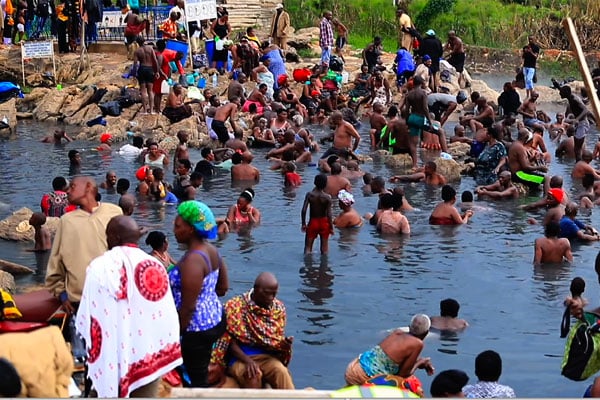Prime
Ebola in the eyes of a Ugandan living in Sierra Leone

An MSF medical worker feeds an Ebola child victim at an MSF facility in Kailahun last week. Kailahun along with Kenama District in Sierra Leone is at the epicentre of the world’s worst Ebola outbreak. Health organisations are looking into the possible use of experimental drugs to combat the latest outbreak in West Africa. AFP photo
The current spread of Ebola in West Africa has been reported as the most deadly, yet the people of Sierra Leone don’t seem fazed by the pronouncement. A Ugandan, Tracy A. Kyakyo, who lived in the country explores why this is the case, from her observations.
In February, the hemorrhagic fever Ebola broke out in southern Guinea. Guinea is a neighbour to the east of Sierra Leone, where I was a resident till mid-June.
Unlike many Sierra Leoneans, my initial reaction, as a Ugandan living in Freetown, was not one of dismissal calling the disease “non-existent”. I remembered very vividly that the Ebola scourge back home had forced many of us away from churches and produced “bonga” (the closed fist greeting) to replace the handshake or anything to curb the virus and giving it power over our societal interactions.
I was, therefore, concerned that Ebola was not very far from the capital. Geographically speaking, south ern Guinea and by association, Ebola, were not more than a six-hour drive away. Ordinarily, people would console themselves that the virus was in another country, however with free and unrestrained movements of people within the 16 countries that make up the Economic Community of West African States (Ecowas), there was reason to fear for the worst.
In all honesty however, I was only mildly worried; after all, Africa had fought Ebola on a large scale on 12 different occasions since 1976.
I also expected quarantines and that the disease would be history by the time Easter came along. So when in March the virus finally made it into Kailahun, a bordering provincial district of Sierra Leone, I was perplexed, but not shocked.
Worse still, there were reports of families entering the said quarantined zones and smuggling out infected relatives. Yet when The Gambia closed its borders in April to people from Sierra Leone, Liberians and Guineans, and Sierra Leoneans laughed them off and said they were being fussy.
We are well into August now and the virus has not shown signs of remission, instead it is spreading like the real life version of the movie Contagion, albeit slower in progression but just as potent. Kenya Airways, the regional airline giant has succumbed to pressure from home as of last week, making her the fifth airline out of the eight that frequent Lungi International Airport, to cancel flights to and from the region.
As I write this, the World Health Organisation reports that the scale of the epidemic is “vastly underestimated” while the President of the medical charity Medicines Sans Frontiers, Joanne Lui says it will take at least six months for the virus to be completely contained. However, many Sierra Leoneans are optimistic, and they are sure all they need is six weeks. Whether they are just being stubborn or exhibiting comic ignorance is debatable.
So far, there have been more than 1,000 deaths spread over the four West African countries of Guinea, Liberia, Sierra Leone and most recently Nigeria and more than 2,000 cases of infections reported.
So the question on many lips now is why the epidemic has lasted this long and spread as far out as it has? While there must be myriad reasons to explain the epidemic aside from the fact that travelling is a way of life, we can only tackle a few of the most obvious here.
INFRUSTRUCTURE
In 2002, Sierra Leone emerged from a decade-long war that left most of its infrastructure and economic structures damaged. Even during my stay, I found that it was easier to self-medicate than go to a health facility which is either substandard or too expensive.
When you have to pay 250,000 Leones ($50) to consult a specialist in the Freetown, you wonder how the locals, a good number of who barely earn a dollar a day manage to get any specialist care. Kailahun and Kenema are the provincial districts that got hit first.
The Kenema Government Hospital and Lassa fever diagnostic centre is located in the region, however, the hospital was nowhere near half equipped to handle the Ebola virus or the epidemic; the Lassa fever ward is a 16-bed facility
SUPERSTITIONS
And for a country that is supposed to have very little cultural heritage because it was mainly comprised of freed slaves, the amount of traditional beliefs and practices is astounding.
For example, on Christmas day and towards the start of the rainy season, the youth dress up as “devils”, and entertain people in the streets. I recall an incident I witnessed of a gentleman complaining of a bad rash on his back and severe body weakness. The medical doctor he had gone too had referred him to a traditionalist who would bury him in the soil to rid him of the rash which we later discovered was a case of the Shingles.
Ebola is a threat and the fear of stigma is real. Many locals believe that the diagnosis is a death sentence and are therefore unwilling to report cases or turn themselves in, especially since they have heard that they do not even get to bury their dead. Consequently, people have become violent, attacking health workers and in Kenema, going as far as to threaten to burn down health centres.
MEDIA AND POLITICS
By June, the Ebola virus was being categorised by supporters of opposition politicians as another political gimmick to keep President Ernest Bai Koroma “saviour from Ebola” in power come 2017 and to get and steal donor funding. Supporters of the ruling All Peoples’ Congress on the other hand spread the word that the virus had been manufactured to overthrow the President. Some opined that Ebola was a means of harvesting people’s organs, no wonder the bodies were not being allowed back for burial. It did not help that this fever called Ebola was being diagnosed in the same hospital that had been treating the Lassa fever over time.
The media in certain cases directly fueled confusion. The Independent Observer published a story in February along with a corresponding photograph of a four year old who had apparently succumbed to the hemorrhagic fever only to apologise two days later, after being pressured by the Ministry of Health that in fact, the virus had not entered Sierra Leone territory just yet.
Slowly the excitement waned and Ebola begun to be employed as a colloquial term to refer to the “corruption and filth” in the government.
In a country with high illiteracy rates, radio is the go-to means of communication but whenever Ebola was mentioned it didn’t mean the virus. Ebola became a homonym.
In the past week alone, there was barely a newspaper headline addressing the subject and even if the radio has been helpful in sensitisation in the last few weeks, there is been a lot of what Sierra Leoneans refer to as “boku tok” (too much talk with little information).
A Sierra Leonean friend, who owns retail stores in two of the affected cities of Freetown and Monrovia (Liberia) asked a journalist last week why no local print media was taking the potency of the virus seriously and he was asked who he had “seen die from the virus with his very own eyes”.
As early as March, companies like London Mining that had sent home their non-essential expatriate staff got a tongue lashing from the press about “abandoning” the country in its time of need.
Another sad fact is that June to September are the dreaded rainy months in which businesses slow down or even halt and most of the well-to-do who are unfortunately in positions of influence, go on their annual vacations.
Technically speaking Ebola couldn’t have had worse timing. The only five star hotel in Sierra Leone, the Radisson Blu Mammy Yoko Hotel registers mainly journalists and medical personnel today while many of the other hotels like Bintumani have closed. Bars, like the popular Obar and The Office were closed as of August following the declaration of emergency and many shops and restaurants are taking the washing of hands with chlorinated water seriously. Intra provincial movement is discouraged but continues; with a little money, you can do just about anything you want.
The fight against Ebola is strong but the number of factors hindering containment are just as strong.
LASSA FEVER
Ebola is not the first hemorrhagic fever to ravage the West African Mano River Union States. Lassa fever was first reported in 1969 and has registered a steady presence in the region during the last decade. According to the July Edition of the Emerging Infectious Diseases’ Journal, it is reported that every year the Ebola-like disease registers between 100,000 and 300,000 infections which result into at least 5,000 deaths. And yet somehow, Lassa fever hasn’t made international news as first as Ebola has. There are questions as to whether the presence of Lassa fever in the region has heightened the number of Ebola infections through some form of mutation.




